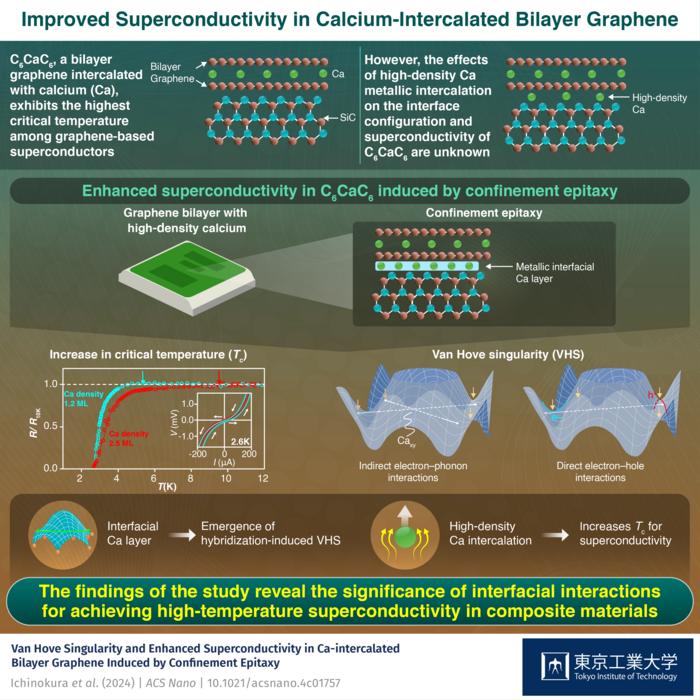Superconductors are materials that can conduct electricity with zero resistance when they are cooled below a certain critical temperature. They have applications in several fields, including magnetic resonance imaging, particle accelerators, electric power, and quantum computing. However, their widespread use is limited by the need for extremely low temperatures. Graphene-based materials are promising for superconductors due to their unique properties such as optical transparency, mechanical strength, and flexibility. Graphene is a single layer of carbon (C) atoms arranged in a two-dimensional honeycomb structure. Among these materials, graphene-calcium (Ca) compound (C6CaC6) exhibits the highest critical temperature. In this compound, a layer of calcium is introduced between two graphene layers in a process called intercalation. While this material already has high critical temperatures, some studies have shown that critical temperatures and therefore superconductivity can be further enhanced through the introduction of high-density Ca.

Credit: Tokyo Tech
Superconductors are materials that can conduct electricity with zero resistance when they are cooled below a certain critical temperature. They have applications in several fields, including magnetic resonance imaging, particle accelerators, electric power, and quantum computing. However, their widespread use is limited by the need for extremely low temperatures. Graphene-based materials are promising for superconductors due to their unique properties such as optical transparency, mechanical strength, and flexibility. Graphene is a single layer of carbon (C) atoms arranged in a two-dimensional honeycomb structure. Among these materials, graphene-calcium (Ca) compound (C6CaC6) exhibits the highest critical temperature. In this compound, a layer of calcium is introduced between two graphene layers in a process called intercalation. While this material already has high critical temperatures, some studies have shown that critical temperatures and therefore superconductivity can be further enhanced through the introduction of high-density Ca.
C6CaC6 is prepared by growing two layers of graphene on a silicon carbide (SiC) substrate followed by exposure to Ca atoms, which leads to intercalation of Ca between the layers. However, it has been expected that intercalation with high-density Ca can lead to variations in the critical temperature of C6CaC6. Particularly, it can lead to the formation of a metallic layer at the interface of the bottom graphene layer and SiC, a phenomenon termed confinement epitaxy. This layer can significantly influence the electronic properties of the top graphene layer, such as giving rise to van Hove singularity (VHS), which can enhance the superconductivity of C6CaC6. However, the experimental validation of this phenomenon is still lacking.
In a recent study, a team of researchers from Japan, led by Assistant Professor Satoru Ichinokura from the Department of Physics at Tokyo Institute of Technology experimentally investigated the impact of high-density Ca introduction to C6CaC6. “We have experimentally revealed that the introduction of high-density Ca induces significant intercalation at the interface leading to the confinement epitaxy of a Ca layer beneath C6CaC6, which gives rise to VHS and enhances its superconductivity,” says Ichinokura. Their study was published online in ACS Nano on May 13, 2024.
The researchers prepared different samples of C6CaC6, with varying densities of Ca, and investigated their electronic properties. The results revealed that the interfacial metallic layer formed between the bottom graphene layer and SiC, at high Ca densities, indeed leads to the emergence of VHS. Moreover, the researchers also compared the properties of C6CaC6 structures with and without the interfacial Ca layer, revealing that the formation of this layer leads to an increase in the critical temperature through the VHS. They further found that VHS increases critical temperatures through two mechanisms. The first is an indirective attractive interaction between electrons and phonons (particles associated with vibrations) and the second is a direct attractive interaction between electrons and holes (vacant spaces left behind by moving electrons). These findings suggest that by introducing high-density Ca, superconductivity can be obtained at higher temperatures, potentially broadening the applicability of C6CaC6 in various fields.
Highlighting potential applications of this material, Ichinokura remarks, “The graphene-calcium compound, being a low-dimensional material composed of common elements, will contribute to the integration and popularization of quantum computers. With quantum computing, large-scale and high-speed computations of complex systems will be possible, enabling the optimization of energy systems towards carbon neutrality and dramatically improving the efficiency of catalyst development and drug discovery through direct simulation of atomic and molecular reactions.”
Overall, the experimental findings of this study can lead to C6CaC6 superconductors with enhanced properties and wide applicability in critical fields.
###
About Tokyo Institute of Technology
Tokyo Tech stands at the forefront of research and higher education as the leading university for science and technology in Japan. Tokyo Tech researchers excel in fields ranging from materials science to biology, computer science, and physics. Founded in 1881, Tokyo Tech hosts over 10,000 undergraduate and graduate students per year, who develop into scientific leaders and some of the most sought-after engineers in industry. Embodying the Japanese philosophy of “monotsukuri,” meaning “technical ingenuity and innovation,” the Tokyo Tech community strives to contribute to society through high-impact research.
Journal
ACS Nano
Method of Research
Experimental study
Subject of Research
Not applicable
Article Title
Van Hove Singularity and Enhanced Superconductivity in Ca-intercalated Bilayer Graphene Induced by Confinement Epitaxy
Article Publication Date
13-May-2024



